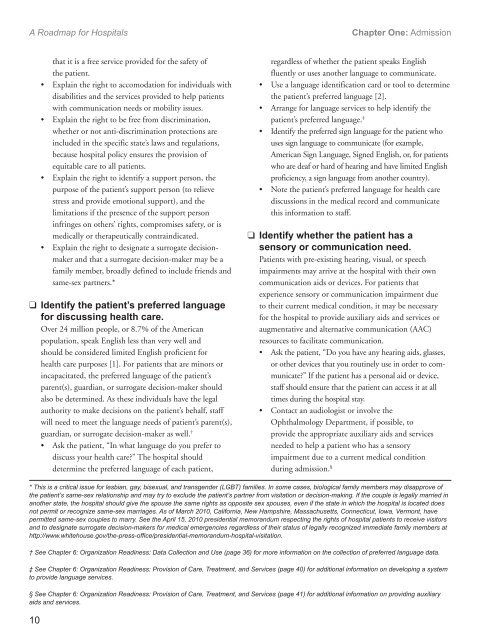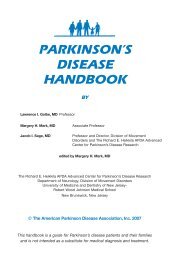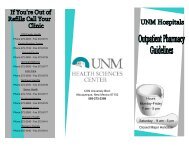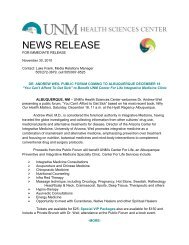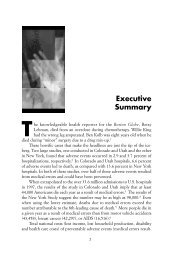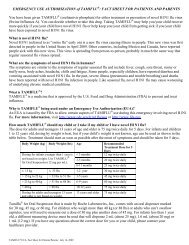Advanced Effective Communication, Cultural Competence, and ...
Advanced Effective Communication, Cultural Competence, and ...
Advanced Effective Communication, Cultural Competence, and ...
Create successful ePaper yourself
Turn your PDF publications into a flip-book with our unique Google optimized e-Paper software.
A Roadmap for Hospitals<br />
Chapter One: Admission<br />
that it is a free service provided for the safety of<br />
the patient.<br />
• Explain the right to accomodation for individuals with<br />
disabilities <strong>and</strong> the services provided to help patients<br />
with communication needs or mobility issues.<br />
• Explain the right to be free from discrimination,<br />
whether or not anti-discrimination protections are<br />
included in the specific state’s laws <strong>and</strong> regulations,<br />
because hospital policy ensures the provision of<br />
equitable care to all patients.<br />
• Explain the right to identify a support person, the<br />
purpose of the patient’s support person (to relieve<br />
stress <strong>and</strong> provide emotional support), <strong>and</strong> the<br />
limitations if the presence of the support person<br />
infringes on others’ rights, compromises safety, or is<br />
medically or therapeutically contraindicated.<br />
• Explain the right to designate a surrogate decisionmaker<br />
<strong>and</strong> that a surrogate decision-maker may be a<br />
family member, broadly defined to include friends <strong>and</strong><br />
same-sex partners.*<br />
❑ Identify the patient’s preferred language<br />
for discussing health care.<br />
Over 24 million people, or 8.7% of the American<br />
population, speak English less than very well <strong>and</strong><br />
should be considered limited English proficient for<br />
health care purposes [1]. For patients that are minors or<br />
incapacitated, the preferred language of the patient’s<br />
parent(s), guardian, or surrogate decision-maker should<br />
also be determined. As these individuals have the legal<br />
authority to make decisions on the patient’s behalf, staff<br />
will need to meet the language needs of patient’s parent(s),<br />
guardian, or surrogate decision-maker as well. †<br />
• Ask the patient, “In what language do you prefer to<br />
discuss your health care?” The hospital should<br />
determine the preferred language of each patient,<br />
regardless of whether the patient speaks English<br />
fluently or uses another language to communicate.<br />
• Use a language identification card or tool to determine<br />
the patient’s preferred language [2].<br />
• Arrange for language services to help identify the<br />
patient’s preferred language. ‡<br />
• Identify the preferred sign language for the patient who<br />
uses sign language to communicate (for example,<br />
American Sign Language, Signed English, or, for patients<br />
who are deaf or hard of hearing <strong>and</strong> have limited English<br />
proficiency, a sign language from another country).<br />
• Note the patient’s preferred language for health care<br />
discussions in the medical record <strong>and</strong> communicate<br />
this information to staff.<br />
❑ Identify whether the patient has a<br />
sensory or communication need.<br />
Patients with pre-existing hearing, visual, or speech<br />
impairments may arrive at the hospital with their own<br />
communication aids or devices. For patients that<br />
experience sensory or communication impairment due<br />
to their current medical condition, it may be necessary<br />
for the hospital to provide auxiliary aids <strong>and</strong> services or<br />
augmentative <strong>and</strong> alternative communication (AAC)<br />
resources to facilitate communication.<br />
• Ask the patient, “Do you have any hearing aids, glasses,<br />
or other devices that you routinely use in order to communicate?”<br />
If the patient has a personal aid or device,<br />
staff should ensure that the patient can access it at all<br />
times during the hospital stay.<br />
• Contact an audiologist or involve the<br />
Ophthalmology Department, if possible, to<br />
provide the appropriate auxiliary aids <strong>and</strong> services<br />
needed to help a patient who has a sensory<br />
impairment due to a current medical condition<br />
during admission. §<br />
* This is a critical issue for lesbian, gay, bisexual, <strong>and</strong> transgender (LGBT) families. In some cases, biological family members may disapprove of<br />
the patient’s same-sex relationship <strong>and</strong> may try to exclude the patient’s partner from visitation or decision-making. If the couple is legally married in<br />
another state, the hospital should give the spouse the same rights as opposite sex spouses, even if the state in which the hospital is located does<br />
not permit or recognize same-sex marriages. As of March 2010, California, New Hampshire, Massachusetts, Connecticut, Iowa, Vermont, have<br />
permitted same-sex couples to marry. See the April 15, 2010 presidential memor<strong>and</strong>um respecting the rights of hospital patients to receive visitors<br />
<strong>and</strong> to designate surrogate decision-makers for medical emergencies regardless of their status of legally recognized immediate family members at<br />
http://www.whitehouse.gov/the-press-office/presidential-memor<strong>and</strong>um-hospital-visitation.<br />
† See Chapter 6: Organization Readiness: Data Collection <strong>and</strong> Use (page 36) for more information on the collection of preferred language data.<br />
‡ See Chapter 6: Organization Readiness: Provision of Care, Treatment, <strong>and</strong> Services (page 40) for additional information on developing a system<br />
to provide language services.<br />
§ See Chapter 6: Organization Readiness: Provision of Care, Treatment, <strong>and</strong> Services (page 41) for additional information on providing auxiliary<br />
aids <strong>and</strong> services.<br />
10


